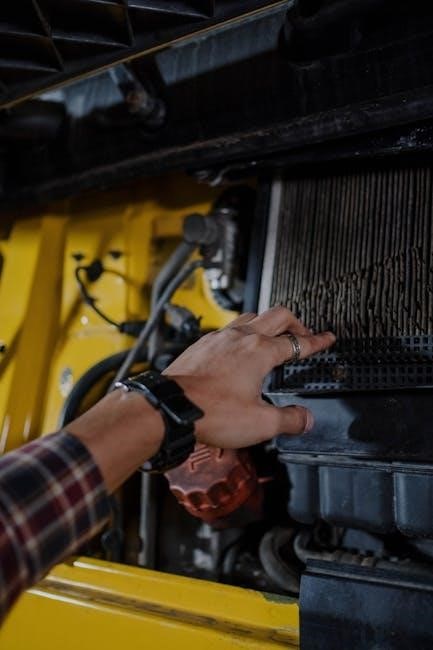Schedule 1 Truck Inspection is a mandatory process for commercial vehicles, ensuring road safety and regulatory compliance through detailed daily inspections of trucks, tractors, and trailers.
1.1 Purpose of Schedule 1 Inspection
The primary purpose of a Schedule 1 inspection is to ensure the safety and operational integrity of commercial vehicles, such as trucks, tractors, and trailers, by identifying defects early. Conducted daily, it helps maintain road safety, reduce mechanical failures, and prevent accidents; The inspection also verifies compliance with legal standards outlined in regulations like Ontario Regulation 199/07. By systematically evaluating critical systems and components, drivers and inspectors can address minor issues before they escalate into major defects. This process fosters a culture of proactive maintenance, protecting both the vehicle and public safety. Additionally, it ensures that commercial vehicles meet the required safety benchmarks, minimizing risks associated with faulty equipment. Through consistent implementation, Schedule 1 inspections contribute to a safer and more reliable transportation industry.
1.2 Legal Requirements and Compliance
Compliance with Schedule 1 inspections is mandated by law, specifically under Ontario Regulation 199/07. This regulation requires daily inspections of commercial vehicles, including trucks, tractors, and trailers, to ensure they meet strict safety standards. Vehicle operators must adhere to these legal requirements to avoid penalties, fines, or operational shutdowns. The regulation outlines the specific systems and components to be inspected, such as brakes, tires, and lighting, ensuring that all defects are documented and addressed promptly. Drivers are also required to carry a copy of Schedule 1 in their vehicles and produce it upon request by law enforcement. Failure to comply may result in legal consequences, emphasizing the importance of rigorous adherence to these regulations. By following Schedule 1, operators not only meet legal obligations but also contribute to a safer transportation environment.

Components of Schedule 1 Inspection
The Schedule 1 inspection includes checking brakes, tires, lights, steering, suspension, and coupling devices, ensuring all minor and major defects are identified and properly documented.
2.1 Systems and Components to Inspect
The Schedule 1 inspection requires a thorough examination of critical vehicle systems and components to ensure safety and compliance. Key areas include the braking system, tires, wheels, lights, electrical connections, steering mechanism, suspension, and coupling devices. Inspectors also check mirrors, seatbelts, and the vehicle frame for structural integrity. Additionally, cargo securement devices are evaluated to prevent load shifting during transit. Each component is assessed for proper function, wear, and damage, with specific attention to identifying minor and major defects. This systematic approach ensures that all potential safety hazards are addressed before the vehicle is operated, aligning with regulatory standards and promoting road safety. By focusing on these essential systems, the inspection process helps maintain the overall reliability and operational readiness of commercial vehicles.
2.2 Minor and Major Defects Identification
During a Schedule 1 inspection, defects are categorized as minor or major based on their impact on vehicle safety and operability. Minor defects, such as worn tires or a cracked mirror, do not immediately compromise safety but require attention. Major defects, like faulty brakes or a damaged frame, pose significant risks and must be repaired before the vehicle operates. Inspectors assess each component against regulatory standards, documenting findings in the inspection report. The process ensures that all issues are identified and classified accurately, with clear guidelines for determining defect severity. This distinction is critical for maintaining road safety and ensuring compliance with transportation regulations. Proper identification and documentation of defects help prevent accidents and facilitate timely maintenance. By distinguishing between minor and major defects, the inspection process prioritizes safety and operational efficiency. This systematic approach ensures that all potential risks are addressed appropriately.

The Process of Conducting a Schedule 1 Inspection
The Schedule 1 Inspection involves a thorough pre-trip and post-trip examination of the vehicle, ensuring all components are checked for safety and compliance. Documentation is mandatory.
3.1 Pre-Trip Inspection Steps
The pre-trip inspection begins with a visual examination of the vehicle’s exterior, including tires, brakes, and lights. Drivers check for proper tire pressure, tread depth, and look for signs of wear or damage on brake pads and rotors. All exterior lights, such as headlights, brake lights, and turn signals, must be functional. The inspection also covers the vehicle’s interior, where drivers ensure that all gauges, warning lights, and controls are operating correctly. Additionally, the driver reviews the vehicle’s documentation, including the Schedule 1 inspection report, to ensure compliance with regulations. Any defects found during the pre-trip inspection must be documented and addressed before the vehicle is allowed to operate. This step is critical for ensuring road safety and preventing potential issues during transit. By following these steps, drivers can identify and rectify issues early, reducing the risk of accidents and legal penalties.
3.2 Post-Trip Inspection Procedures
The post-trip inspection is a critical step in ensuring vehicle safety and compliance after completing a journey. Upon returning, drivers must thoroughly inspect the truck, tractor, or trailer for any damage or wear that may have occurred during the trip. This includes checking tires for signs of wear or damage, brakes for proper function, and exterior lights to ensure they are operational. The inspection also involves reviewing the vehicle’s systems, such as the engine, transmission, and suspension, for any abnormalities. Drivers must document any defects or issues found during the post-trip inspection and report them to the appropriate personnel for corrective action. This process helps maintain roadworthiness and prevents potential safety hazards in future trips. By adhering to these procedures, drivers contribute to a safer and more efficient transportation process.
Documentation and Reporting
Accurate documentation of inspection findings is crucial for compliance; Reports must detail defects, repairs, and compliance status, ensuring transparency and accountability in maintaining vehicle safety standards.
4.1 Schedule 1 Inspection Report Format
The Schedule 1 Inspection Report is structured in a three-column format, detailing systems/components, minor defects, and major defects. Each section is clearly defined to ensure comprehensive documentation of vehicle condition. The report includes specific codes for identified issues, facilitating quick reference and standardized reporting. Date, time, odometer reading, and location are mandatory fields to provide context for each inspection. The format also requires the carrier’s name and additional remarks for any supplementary information. This structured approach ensures consistency and clarity, making it easier for authorities to review and verify compliance. Proper completion of the report is essential for maintaining accurate records and demonstrating adherence to regulatory requirements. The format is designed to be user-friendly while meeting legal standards, ensuring that all critical aspects of vehicle safety are thoroughly assessed and documented. This standardized method promotes accountability and helps in tracking recurring issues for proactive maintenance. By following this format, inspectors can efficiently capture all necessary details, supporting both compliance and safety objectives. The report serves as a vital tool for ensuring that commercial vehicles operate safely and legally on public roads. Its structured design aids in identifying and addressing potential risks before they lead to accidents or legal penalties. Overall, the Schedule 1 Inspection Report format is a cornerstone of effective vehicle management and regulatory compliance in the transportation industry.
4.2 Maintaining Inspection Records
Maintaining accurate and complete inspection records is crucial for compliance and accountability. Records must be stored securely, either physically or digitally, for a minimum of 12 months. Each inspection report should include the date, time, vehicle details, and a clear listing of defects, if any. Inspection records serve as proof of compliance with Schedule 1 requirements and are often requested by regulatory authorities during audits or roadside inspections. Carriers and drivers must ensure that all documentation is legible, properly dated, and signed by the inspector. Digital systems can streamline record-keeping, reducing errors and improving accessibility. Properly maintained records also aid in identifying recurring issues, enabling proactive maintenance and enhancing safety. Failure to maintain adequate records can result in penalties, fines, or operational restrictions. Thus, meticulous record-keeping is essential for legal compliance and operational efficiency in the transportation industry. Accurate documentation safeguards both the carrier and driver from potential liabilities. Consistent and organized record maintenance is a critical component of Schedule 1 adherence.
Importance of Compliance with Schedule 1
Compliance with Schedule 1 ensures road safety, prevents accidents, and avoids legal penalties. It promotes vehicle reliability and maintains operational efficiency, crucial for the transportation industry’s smooth functioning and reputation.

5.1 Consequences of Non-Compliance
Non-compliance with Schedule 1 inspections can lead to severe penalties, including fines and legal action. Vehicles found with major defects may be placed out of service until repairs are made. Companies failing to adhere to regulations risk damaging their reputation and facing increased scrutiny from regulatory bodies. Additionally, non-compliance can result in higher insurance premiums and operational disruptions. Drivers and carriers may also face suspension of their operating licenses, further impacting business continuity. The financial and reputational consequences underscore the importance of adhering to Schedule 1 requirements. Regular inspections not only ensure safety but also protect fleets from potential legal and financial repercussions. Proactive compliance is essential to maintain smooth operations and avoid costly penalties.
5.2 Benefits of Regular Inspections
Regular Schedule 1 inspections offer numerous benefits, enhancing safety, efficiency, and compliance. By identifying and addressing issues early, inspections prevent minor defects from escalating into costly repairs. This proactive approach reduces downtime, ensuring vehicles remain operational and productive. Improved road safety is another critical advantage, as inspections minimize the risk of accidents caused by faulty equipment. Compliance with regulations avoids penalties and maintains a positive reputation for carriers. Additionally, regular inspections can lower insurance premiums and extend vehicle lifespan. They also foster a culture of safety and responsibility among drivers and maintenance teams. Ultimately, consistent inspections contribute to smoother operations, reduced expenses, and enhanced overall fleet performance. These benefits highlight the importance of integrating regular inspections into daily operations for long-term success and reliability.
Best Practices for Implementing Schedule 1
Adopting standardized procedures, leveraging technology, and providing ongoing training ensure effective implementation of Schedule 1 inspections, enhancing compliance and operational efficiency across fleets.
6.1 Driver Training and Awareness
Effective driver training is crucial for ensuring compliance with Schedule 1 inspections. Drivers should receive comprehensive education on identifying minor and major defects, understanding legal requirements, and completing inspection reports accurately. Regular refreshers and updates on regulatory changes help maintain awareness and adherence to protocols. Training programs should include hands-on practice, allowing drivers to familiarize themselves with inspection procedures and documentation processes. By fostering a culture of safety and accountability, fleets can reduce non-compliance risks and promote efficient inspections. Additionally, incorporating real-world scenarios and case studies into training materials enhances understanding and practical application of Schedule 1 guidelines.
6.2 Using Technology for Efficient Inspections
Integrating technology into Schedule 1 inspections enhances efficiency and accuracy. Digital inspection tools, such as mobile apps and software, allow drivers to streamline the process, reducing paperwork and errors. These platforms often include checklists, defect tracking, and real-time reporting features, ensuring compliance with regulatory standards. Some systems utilize barcode scanning or RFID tags for quick identification of inspected components. Cloud-based solutions enable seamless data sharing between drivers, fleet managers, and maintenance teams, facilitating prompt issue resolution. Additionally, technologies like AI-powered defect detection can aid in identifying potential issues early, improving safety outcomes. By adopting these tools, fleets can modernize their inspection processes, reduce administrative burdens, and ensure adherence to Schedule 1 requirements more effectively.

